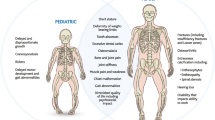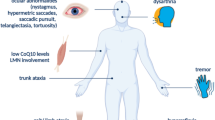Abstract
The protein product of the progressive ankylosis gene, known as ANK, is a 492-amino acid multi-pass transmembrane protein. This protein is critical for the regulation of pyrophosphate, and gain of function ANK mutations is associated with calcium pyrophosphate deposition disease. Much about the structure, function, and regulation of ANK remain unstudied. This review of the current literature examines recent contributions to our understanding of ANK. We focus on new work on the function, binding partners, and regulators of ANK. A more complete understanding of this important protein may help to identify future therapeutic targets for the treatment of calcium pyrophosphate deposition disease.
Similar content being viewed by others
References
Papers of particular interest, published recently, have been highlighted as: • Of importance •• Of major importance
Ryan L, Cheung H, McCarty D. Release of pyrophosphate by normal mammalian articular hyaline and fibrocartilage in organ culture. Arthritis Rheum. 1981;124:1522–7.
Zitnan D, Sitaj S. Chondrocalcinosis articularis: Section I. Clinical and radiological study. Ann Rheum Dis. 1963;22:142–52.
Couto AR et al. Investigating ANKH and ENPP1 in Slovakian families with chondrocalcinosis. Rheumatol Int. 2012;32(9):2745–51.
Ho A, Johnson M, Kingsley D. Role of the mouse ank gene in tissue calcification and arthritis. Science. 2000;289:265–70.
Williams C. Familial calcium pyrophosphate dihydrate deposition disease and the ANKH gene. Curr Opin Rheumatol. 2003;15:326–31.
Uzuki M et al. Upregulation of ANK protein expression in joint tissue in calcium pyrophosphate dihydrate crystal deposition disease. J Rheumatol. 2014;41(1):65–74. This study underscores the differential expression of ANK in osteoarthritic cartilage and cartilage containing CPP crystals.
Hirose J, Ryan L, Masuda I. Up-regulated expression of cartilage intermediate-layer protein and ANK in patients with calcium pyrophosphate dihydrate crystal deposition disease. Arthritis Rheum. 2002;46:3218–29.
Gurley K, Reimer R, Kingsley D. Biochemical and genetic analysis of ANK in arthritis and bone disease. Am J Human Genetics. 2006;79:1017–29.
Ryan L. The ank gene story. Arthritis Res. 2001;3:77–9.
Yepes M et al. Progressive ankylosis (Ank) protein is expressed by neurons and Ank histochemical reactivity is increased by limbic seizures. Lab Invest. 2003;83:1025–32.
Prosdocimo D et al. Autocrine ATP release coupled to extracellular pyrophosphate accumulation in vascular smooth muscle cells. Am J Physiol Cell Physiol. 2009;296:C828–39.
Rosenthal AK et al. The progressive ankylosis gene product ANK regulates extracellular ATP levels in primary articular chondrocytes. Arthritis Res Ther. 2013;15(5):R154. This manuscript highlights a role for ANK in ATP transport. Using siRNA technology, ANK silencing led to decreased extracellular ATP. These findings were further supported by treatment of chondrocytes with probenecid, an ANK blocker.
Las Heras F et al. Aberrant chondrocyte hypertrophy and activation of beta-catenin signaling precede joint ankylosis in ank/ank mice. J Rheumatol. 2012;39(3):583–93.
Wang J et al. Microcytosis in ank/ank mice and the role of ANKH in promoting erythroid differentiation. Exp Cell Res. 2007;313:4120–9.
Kirsch T, Kim H, Winkles J. Progressive ankylosis gene (ank) regulates osteoblast differentiation. Cells Tissues Organs. 2009;189:158–62.
Kim HJ et al. Progressive ankylosis protein (ANK) in osteoblasts and osteoclasts controls bone formation and bone remodeling. J Bone Miner Res. 2010;25(8):1771–83.
Nurnberg P et al. Heterozygous mutations in ANKH, the human ortholog of the mouse progressive ankylosis gene, result in craniometaphyseal dysplasia. Nat Genet. 2001;28(1):37–41.
Zaka R, Williams C. Role of the progressive ankylosis gene in cartilage mineralization. Curr Opin Rheumatol. 2006;18:181–6.
Wang J et al. The ANKH ΔE490Mutation in Calcium Pyrophosphate Dihydrate Crystal Deposition Disease (CPPDD) Affects Tissue Non-specific Alkaline Phosphatase (TNAP) Activities. Open Rheumatol J. 2008;2:23–30.
Gruber BL et al. Novel ANKH amino terminus mutation (Pro5Ser) associated with early-onset calcium pyrophosphate disease with associated phosphaturia. J Clin Rheumatol. 2012;18(4):192–5. This paper highlights yet another ANK mutation and its association with CPPD disease.
Abhishek A et al. The association between ANKH promoter polymorphism and chondrocalcinosis is independent of age and osteoarthritis: results of a case-control study. Arthritis Res Ther. 2014;16(1):R25.
Zhang Y et al. Association of sporadic chondrocalcinosis with a -4 basepair G to A transition in the 5’ untranslated region of ANKH that promotes expression of ANKH protein and excess generation of extracellular inorganic pyrophosphate. Arthritis Rheum. 2005;52:1110–7.
Peach CA et al. Cuff tear arthropathy: evidence of functional variation in pyrophosphate metabolism genes. Clin Orthop Relat Res. 2007;462:67–72.
Harmey D et al. Concerted regulation of inorganic pyrophosphate and osteopontin by Akp2, Enpp1 and Ank. Am J Pathol. 2004;164:1199–209.
Tomaszewski KA et al. Degeneration and calcification of the cervical endplate is connected with decreased expression of ANK, ENPP-1, OPN and TGF-beta1 in the intervertebral disc. Pol J Pathol. 2014;65(3):210–7. This is a large scale immunohistochemistry study exploring the expression of ANK and ENPP1 in degenerated cervical discs.
Li X, Yang HY, Giachelli CM. Role of the sodium-dependent phosphate cotransporter, Pit-1, in vascular smooth muscle cell calcification. Circ Res. 2006;98(7):905–12.
Wang J et al. The CPPDD-associated ANKH M48T mutation interrupts the interaction of ANKH with the sodium/phosphate cotransporter PiT-1. J Rheumatol. 2009;36(6):1265–72.
Minashima T et al. The role of ANK interactions with MYBBP1a and SPHK1 in catabolic events of articular chondrocytes. Osteoarthritis Cartilage. 2014;22(6):852–61. This fascinating study explored new binding partners of ANK. The researchers also suggest another role for ANK beyond PPi transport.
Sohn P et al. Developmental and TGF-beta-mediated regulation of Ank mRNA expression in cartilage and bone. Osteoarthritis Cartilage. 2002;10(6):482–90.
Zhao G et al. Activation of nuclear factor-kappa B accelerates vascular calcification by inhibiting ankylosis protein homolog expression. Kidney Int. 2012;82(1):34–44. These researchers discussed the role of ANK in inhibiting vascular calcification and the role of inflammation in disrupting ANK expression.
Nasi S, et al. Interleukin-6 and chondrocyte mineralisation act in tandem to promote experimental osteoarthritis. Ann Rheum Dis, 2015.
Du G, et al. Abnormal Mechanical Loading Induces Cartilage Degeneration by Accelerating Meniscus Hypertrophy and Mineralization After ACL Injuries In Vivo. Am J Sports Med. 2016.
Zaka R et al. Oxygen tension regulates the expression of ANK (progressive ankylosis) in an HIF-1-dependent manner in growth plate chondrocytes. J Bone Miner Res. 2009;24(11):1869–78.
Xu H-G et al. Effects of mechanical strain on ANK, ENPP1 and TGF-B1 expression in rat endplate chondrocytes in vitro. Mol Med Reports. 2011;4:831–5.
Xu HG et al. JNK phosphorylation promotes natural degeneration of cervical endplate chondrocytes by down-regulating expression of ANK. Eur Rev Med Pharmacol Sci. 2013;17(17):2335–44. These papers discuss the role of JNK phosphorylation in both rat and human cervical endplate degeneration. This phosphorylation down-regulates ANK expression.
Xu HG et al. JNK phosphorylation promotes degeneration of cervical endplate chondrocytes through down-regulation of the expression of ANK in humans. Chin Med J (Engl). 2013;126(11):2067–73.
Rendenbach C et al. Effects of extracellular phosphate on gene expression in murine osteoblasts. Calcif Tissue Int. 2014;94(5):474–83.
Foster BL et al. Central role of pyrophosphate in acellular cementum formation. PLoS One. 2012;7(6):e38393. The role of ANK in Pi/PPi homeostasis was investigated. A feed-forward loop was established in which mineralization involves coordinate regulation of ANK and ENPP1.
Cailotto F et al. Inorganic pyrophosphate generation by transforming growth factor-beta-1 is mainly dependent on ANK induction by Ras/Raf-1/extracellular signal-regulated kinase pathways in chondrocytes. Arthritis Res Ther. 2007;9(6):R122.
Cailotto F et al. The inorganic pyrophosphate transporter ANK preserves the differentiated phenotype of articular chondrocyte. J Biol Chem. 2010;285:10572–82.
Xu HG et al. Investigating conversion of endplate chondrocytes induced by intermittent cyclic mechanical unconfined compression in three-dimensional cultures. Eur J Histochem. 2014;58(3):2415.
Belinsky GS et al. The contribution of methotrexate exposure and host factors on transcriptional variance in human liver. Toxicol Sci. 2007;97(2):582–94.
Author information
Authors and Affiliations
Corresponding author
Ethics declarations
Conflict of Interest
EMF, CMG, BB, and AKR declare that they have no conflicts of interest.
Human and Animal Rights and Informed Consent
This article does not contain any studies with human or animal subjects performed by any of the authors.
Rights and permissions
About this article
Cite this article
Mitton-Fitzgerald, E., Gohr, C.M., Bettendorf, B. et al. The Role of ANK in Calcium Pyrophosphate Deposition Disease. Curr Rheumatol Rep 18, 25 (2016). https://doi.org/10.1007/s11926-016-0574-z
Published:
DOI: https://doi.org/10.1007/s11926-016-0574-z




